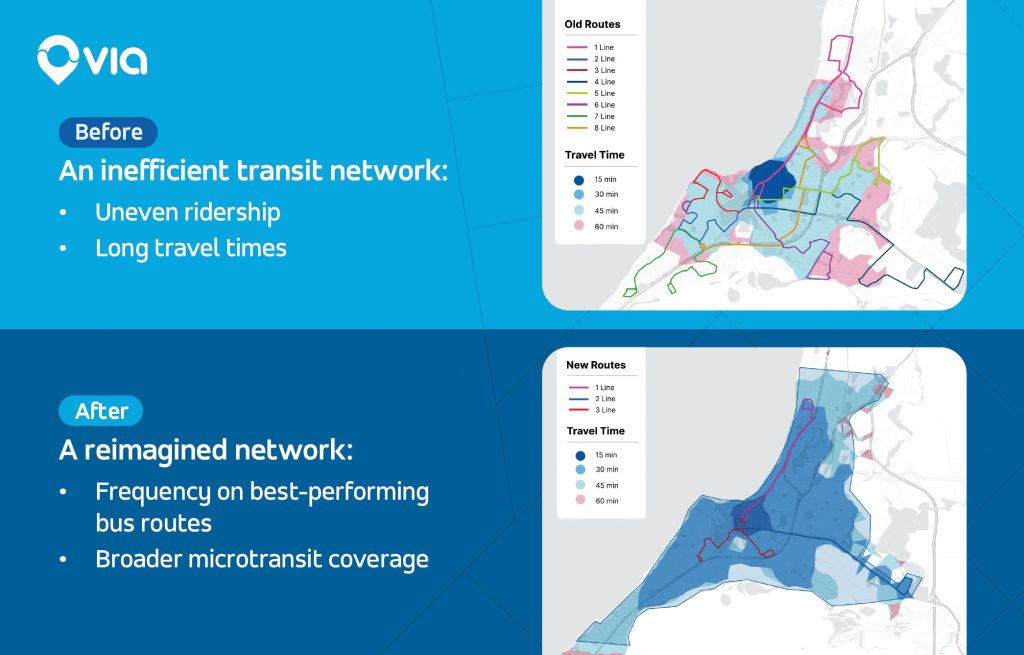Via: Integrated transit technology creates more efficient, rider-friendly transit networks
5/6/2024
SPECIAL ADVERTISING SECTION

In Sioux Falls, South Dakota, the transit network looks similar to those of mid-sized cities across the United States: a dozen bus routes, paratransit service, weekend microtransit. But under the surface, something radical is happening, and setting the stage for a dramatic network evolution. What’s changed? On January 1st, 2024, Sioux Falls transitioned its entire transit system to the Via platform — and entered the era of what we’re calling “Integrated Transit,” a multimodal, whole-network approach enabled by Via’s industry-leading TransitTech.
Beyond the microtransit pilot
At first glance, managing an entire network may seem new for Via. But for years, we’ve been building technology and operational capabilities within a whole-network mindset that balances system-wide efficiency with rider experience — whether we run a city’s entire network ourselves, just provide technology, or operate microtransit within a broader transit ecosystem.

Fixed-route services clearly have the potential to operate more cost-effectively than microtransit. So when a city’s density and travel patterns support high-quality bus service, we prioritize it. In Summit County, Utah, where Via operates High Valley Transit’s entire network, we helped the agency redesign bus routes to run at higher frequencies, while adding microtransit for first- and last-mile connections. We’ve delivered 2+ million trips since launch in 2021 — and more than half of those were on the bus.
But when fixed-route services perform poorly, it comes at a cost: the per-trip cost on some bus lines, particularly in less dense areas, can climb above $20, or even $30. Not only can microtransit do better on cost in many places, it can also provide broader coverage and better quality service when deployed thoughtfully. When Wilson, North Carolina, converted its underperforming fixed-route network to microtransit, the city reduced overall cost-per-trip from $16 to $10. At the same time, they extended coverage by 150% and improved service quality, reducing hour-long bus headways to 15-20 minute wait times.
Both Summit and Wilson embody the Integrated Transit, whole-network approach that’s behind Sioux Falls’ transit transformation. In all three places, the thinking is the same: how can tech-enabled solutions help transit providers put the right mode in the right place — or as one of our team members puts it, “the right butt in the right seat?”
New technology for classic transit-planning
Via’s Integrated Transit technology arms planners with the data and tools they need to design and analyze successful multimodal transit services. At the same time, it offers transit providers a platform to manage multiple modes in a complementary and integrated way, while giving riders an easy way to navigate what could otherwise be an intimidating multimodal network.

With Integrated Transit technology, transit systems will be:
Rider-centric.
We’re building networks driven by rider needs and abilities. When a rider requests a trip in our app, they receive a custom journey with carefully-timed connections and clear transfer instructions, all of which accommodate the needs they’ve already specified in their rider profile. One rider might get a paratransit vehicle straight to their destination; another might take microtransit to the bus stop, and the bus the rest of the way.
Integrated.
With all transit modes sitting atop the same digital infrastructure, transit providers set the rules for how they interact with one another — and the public. If you want to prioritize microtransit trips late at night, you can. If a bus is delayed, any transfers will account for its real-time position. If some paratransit riders’ needs can be met with lower-cost microtransit service, they’ll receive trip proposals that include it.
Dynamic.
Intermodal connectivity and real-time data make it possible to adjust supply in the moment to meet unexpected demand. If a bus breaks down, adding more microtransit drivers can alleviate the strain on the network. Over time, usage patterns can guide adjustments to fixed-route service — and riders using the app to navigate the network may not even notice there’s been a change.
Efficient.
All of this means you can accomplish your coverage and service quality goals while achieving best-ever operational efficiency. Cost-per-trip can be assessed line by line, mode by mode, and passengers routed to lower-cost options when they meet the service quality standards you’ve set.
Integrated Transit isn’t a single product, or an all-or-nothing solution. It’s a way of thinking about how technology can further transit planners’ goals, and facilitate holis-tic connectivity throughout a city or region. These are the transit systems of the future—and they’re already here.
Daniel Berkovits
Vice President of Strategy at Via
For more information about Via and integrated transit, please visit ridewithvia.com or reach out at partnerships@ridewithvia.com.